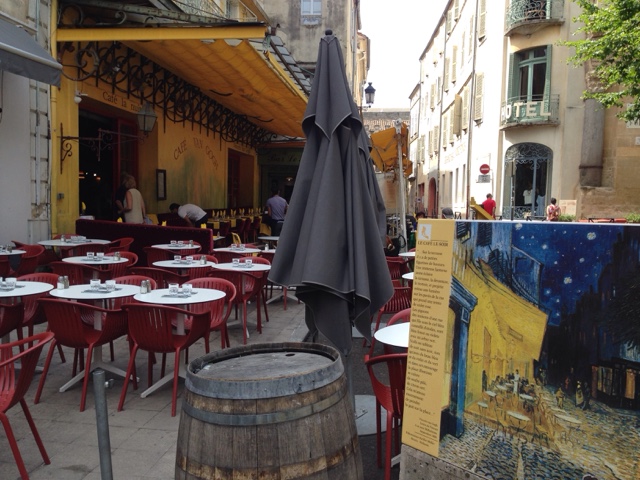June 14, 2015
Arles, France
A typical Roman city such as Arles was a garrison town, laid out on a grid plan with two main roads: one running north-south, the other east-west. Approaching the city on your chariot, you would pass by the cemetery then enter the main gate then speed to the forum (town square).
Nearby, you would find the bathhouse that served the almost sacred dedication to personal vigor.
This is a model of the Arles Roman bathhouse.
This is what remains of it 2,000 years later.
Thermes de Constantin (Baths of Constantine) were built in the early 4th century when Emperor Constantine declared Arles an imperial residence. These baths were used for exercising, networking, and chatting with friends as well as bathing.
Roman Arles had a population of 100,000--double today's size.
The Theatre Antique seated 10,000; it was an elegant, three-level structure.
During the Middle Ages the old theater became a convenient town quarry--St. Trophine Church was built from theater rubble.
A three-story stage wall featured more than 100 columns and statues painted in vibrant colors. Actors with main roles entered through the central arch, over which a grandiose statue of Caesar Augustus stood.
The bright-yellow cafe called Cafe la Nuit was the subject of one of Vincent Van Gogh's most famous works in Arles.
In winter 1888, 35-year-old Dutch artist Vincent van Gogh left Paris for Provence. He was lonely yet inspired; coming from the gray skies and flat lands of the north he now would experience the sun, bright colors and rugged landscape.
For the next two years he painted furiously, cranking out a masterpiece every few days.
Only a few of the 200-plus paintings that Van Gogh did in the south can be found today in Arles;
however, visitors can walk the streets he walked and see places he painted marked by about a dozen steel & concrete easels with photos of the final paintings.
St. Trophine Church has a very entertaining exterior. The facade trumpets the promise of Judgment day. The 12 apostles are lined up below Jesus and some people are saved and some are not.
Among the condemned on the right is a chain-gang doing a sad bunny-hop over the fires of hell.
Below the chain-gang, St. Stephen is being stoned to death, with his soul leaving through his mouth and instantly being welcomed by angels. In an illiterate medieval world, this art would have carried a clear message.
Nearly 2,000 years ago, gladiators fought wild animals in the Roman Arena to the delight of 20,000 screaming fans.
In Roman times games were free, sponsored by city officials. Fans were seated by social class.
More than 30 rows of stone bleachers extended to the top of the arches that circle the arena.
There were no gates, just welcoming arches, allowing fans to come and go freely.
The purpose was to create a populace that was thoroughly Roman--enjoying the same activities and entertainment and thinking as one.
The many passageways allowed for rapid dispersal after the games-- fights would break out among frenzied fans if they couldn't leave quickly.
During medieval times and until the early 1800's, the arches were bricked up and the stadium became a fortified town with 200 humble homes crammed within its circular defenses.
Named for the Roman forum that once stood here, Place du Forum was the political and religious center of Roman Arles.
Provence, with its strategic location, benefited greatly from Rome's global economy. Most cities had a theater, baths, aqueducts and sports arenas. The Roman-built city of Arles was a crucial link in the trade route from Italy to Spain so they built a bridge across the Rhone River and fortified the town.
A model of the Arles Roman forum--how it originally looked.
This is a model of the chariot race course that sat on the edge of town. Look closely to see the tiny charioteers. Go Ben-Hur!
We walked back to our camping spot alongside the Rhone River























No comments:
Post a Comment